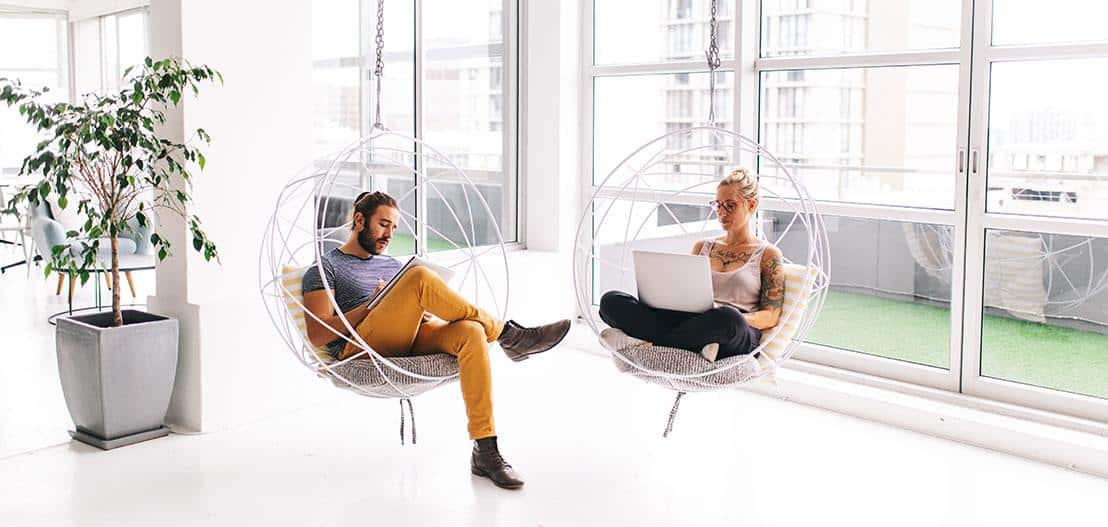Today’s office environment is all about collaboration: our computers are constantly pinging with direct messages from our colleagues; innovation is key to function; and working in teams is often preferable to working solo. So it’s no surprise that cubicles (the standard for offices since the 1960s when a guy named Herman Miller created them) appear to have fallen to the wayside in the name of healthy workplace culture.
But should you welcome the open office concept into your space? We looked at it from all angles.
What is the open office?
There can be a range of interpretations of the open office plan, but it essentially describes an office designed for increased collaboration. More specifically, open office spaces tend to lack cubicles so that employees can see each other and interact easily. Rather than individual desks, some offices have large tables or open seating areas. Regardless, the end goal is to have a space without anything limiting the employees’ collaborating abilities.
Open office plans originated in Silicon Valley, when companies tore down the walls in lieu of communal desks. They also ditched the traditional offices to eschew corporate hierarchy. And the office plan designed for an “everyone’s in it together” mindset has caught on quickly. The number of offices with open floor plans jumped to more than 70 percent about 6 years ago and remaining that way, present in big-name companies like Facebook, a 10-acre building containing an entirely open-concept plan. Even CEO Mark Zuckerberg has his own plain white desk in that open space (though he often works in his private conference room, which goes against the concept).

The pros
Our Mark Z side comment wasn’t snarky- open office plans are all about collaboration and communication. The reason why so many companies have jumped onto the open office bandwagon is because they’re designed to increase communication between colleagues. Since there are few physical barriers, it’s supposed to be easier to chat with your peers, exchanging creative ideas that could become the next big thing. A study by the MIT Media Lab found that the closer desks are spaced together, the more two people will interact (which for those of you who have kids in school, seems pretty obvious). So the greater the number of interactions you have with your co-workers (as long as you’re not spending the entire time passing notes) the better the outcome.
Another reason why employers like the open space concept is because they can oversee their employees much easier without the barriers. No one can hide in their offices or within a cubicle, which some employees feel is a bonus to the open concept. This should, in theory, also lead to the employees staying in the present moment without distractions because they’re out in the open. It’s a persuasive argument, though employees may not feel as satisfied with this arrangement for the same reason.
If an office hasn’t been built out yet, then the open plan is relatively inexpensive compared with a traditional office space. Instead of purchasing separate cubicles and creating offices for higher-ups, you can simply pop in large tables for the communal space. Seating can be flexible, and can range from the tables to couches, desks and whatever will encourage teamwork.
If the arrangement doesn’t work, you can rearrange the space and try again easily.
The open office concept can even work if you plan to rent a room in a co-working space, if you’re starting a business out of your basement or garage or anywhere you have some free space. In this sense, it can almost be an old-fashioned office turned fashionable again given the name, “open concept.” Since no one will have their own office, the actual size of the space can be smaller than a traditional space, as it can accommodate more people.

The cons
Without walls or dividers, the open concept office can get very loud and may be distracting, especially for those who find it difficult to focus. Various studies have found that open office distractions decrease productivity between 15 to 28 percent, so it’s no surprise that the top complaint from those working in open offices is noise.
You’ll also have a few things to take into consideration: do your employees need to make frequent phone calls? Would they need to leave the space and go into a designated phone space to make the calls? What about video conferencing? And while the point of the open office is to increase human interaction, it doesn’t always have the intended effect. Research published in the Harvard Business Review found that when companies switch to open concepts – face-to-face interactions fall by 70 percent while email interactions jumped by 50 percent.
It doesn’t seem to make much sense: co-workers can see and talk to each other much easier without the cubes and walls, so why wouldn’t the interaction increase? One reason is that the open concept adds a fourth wall. Essentially, workers need to establish some way to limit the new distractions that perk up without walls. So they look more intently at their work; they act annoyed if they’re disrupted; they make it clear that they’re working. These are all actions they didn’t necessarily take previously, because the distractions and interruptions were less frequent.
Adding to all the distractions is the stress. Researchers at Queensland University of Technology found that 90 percent of those working in an open office had high levels of stress and job turnover. Another study found that those in the open offices took 62 percent more sick days than those in traditional offices. Privacy – even in an office environment – is important, and the lack of all privacy stemming from the open office, can lead to increased stress levels as well.

Make it work
If you’ve decided to spring for the open office, you should keep some ground rules in mind.
- While the goal is increased interaction, it’s impossible to work while being constantly interrupted. Perhaps you can section off an area where it’s an interruption-free zone: this would be a table where employees could work silently when needed.
- There should be a designated area for phone calls and other chatter. Some offices even create actual phone booths.
- You need a code of conduct when it comes to speaking with other employees while they’re working, or interruptions could be endless. If they’re wearing headphones, then perhaps this means they don’t want to speak?
There are pros and cons to the open office space, so nothing’s stopping you from taking a little of both worlds. It’s possible to have sections of the office be open space – or even rooms where teams can meet without walls or cubes. There can also be larger areas that have privacy spaces for those who want to work sans distraction.
It’s up to you, but like we said in the beginning, your office space says a lot about your company culture. Are you keeping up with all of the modern trends that make sense for your business? By trying out innovative ways to make your place of work a more creative, engaging place to be, you’re showing a generation of new hires that you’re worth applying to. Plus, you’re reinvigorating the excitement your current workers used to feel when they first started working at your company. Change can be a big deal- but in this case, it’s totally worth it.







